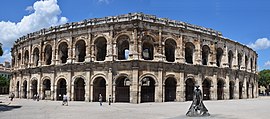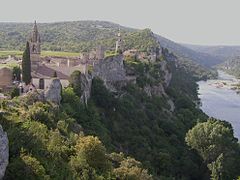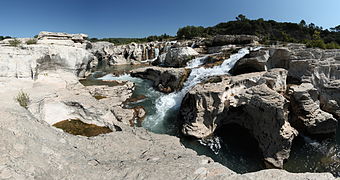
Lozère is a landlocked department in the region of Occitanie in Southern France, located near the Massif Central, bounded to the northeast by Haute-Loire, to the east by Ardèche, to the south by Gard, to the west by Aveyron, and the northwest by Cantal. It is named after Mont Lozère. With 76,604 inhabitants as of 2019, Lozère is the least populous French department.
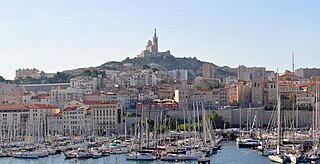
Bouches-du-Rhône is a department in southern France. It borders Vaucluse to the north, Gard to the west and Var to the east. The Mediterranean Sea lies to the south. Its prefecture and largest city is Marseille; other important cities include Aix-en-Provence, Arles, Martigues and Aubagne.

Aude is a department in Southern France, located in the Occitanie region and named after the river Aude. The departmental council also calls it "Cathar Country" after a group of religious dissidents active in the 12th to 14th centuries.

Tarn is a department in the Occitania region in Southern France. Named after the river Tarn, it had a population of 389,844 as of 2019. Its prefecture and largest city is Albi; it has a single subprefecture, Castres. In French, the inhabitants of Tarn are known as Tarnais (masculine) and Tarnaises (feminine). Its INSEE and postcode number is 81.

Hérault is a department of the region of Occitania, Southern France. Named after the Hérault River, its prefecture is Montpellier. It had a population of 1,175,623 in 2019.

Lot is a department in the Occitanie region of France. Named after the Lot River, it lies in the southwestern part of the country and had a population of 174,094 in 2019. Its prefecture is Cahors; its subprefectures are Figeac and Gourdon.

Nîmes is the prefecture of the Gard department in the Occitanie region of Southern France. Located between the Mediterranean Sea and the Cévennes, the commune of Nîmes had an estimated population of 148,561 in 2019.
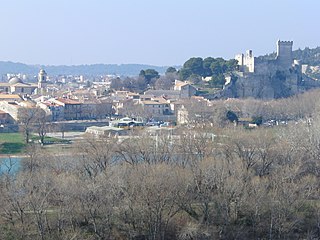
Beaucaire is a commune in the Gard department in the Occitanie region of Southern France.

Villeneuve-lès-Maguelone is a commune in the Hérault department in the Occitanie region in Southern France. Villeneuve-lès-Maguelone station has rail connections to Narbonne, Montpellier and Avignon.

The arrondissement of Nîmes is an arrondissement of France in the Gard department in the Occitanie region. It has 181 communes. Its population is 564,024 (2021), and its area is 3,188.3 km2 (1,231.0 sq mi).

The arrondissement of Le Vigan is an arrondissement of France in the Gard department in the Occitanie region. It has 74 communes. Its population is 39,330 (2021), and its area is 1,390.6 km2 (536.9 sq mi).

Villetelle is a commune in the Hérault department in the Occitanie region in southern France.

Aniane is a commune in the Hérault department in the Occitanie region in southern France.

Saint-Thibéry is a commune in the Hérault département in the Occitanie region in southern France.

Le Grau-du-Roi is a commune in the Gard department in southern France. It is the only commune in Gard to have a frontage on the Mediterranean. To the west is the Herault department and La Grande-Motte village, and to the east is the Bouches-du-Rhone department. Using the sea as a vantage point, the commune has four distinct sections: the right beach, the Village, the left beach, Port-Camargue and L'Espiguette. Immediately landwards are the large shallow étangs, saline marshes, which separate it from Aigues Mortes, a neighboring mediaeval walled city that used to be a port. The étangs are home to numerous flamingoes.
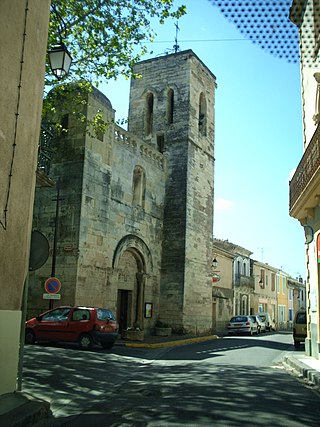
Le Cailar is a commune in the Gard department in southern France. It is located at the confluence of the River Vistre and the River Rhôny. It was an important port during the Iron Age at a time when lagoons connected to the Mediterranean Sea covered the adjoining low-lying land.

Alignan-du-Vent is a commune in the Hérault department in the Occitanie region in southern France.

Saint-Bauzille-de-la-Sylve is a commune in the Hérault department in the Occitanie region in southern France.

Quarante is a commune in the Hérault department in the Occitanie region in southern France. Quarante is a hilltop medieval village from the Gallo-Roman era, just 1 km from the famous 17th century Canal du Midi, 8 km from Capestang, 25 km from Béziers, and 35 km from the Mediterranean Sea. The closest train station and regional airport is in Béziers, and 59 km to the north is the city of Carcassonne, famous for its medieval walled citadel. International airports within an hour are; Carcassonne, Perpignan, Montpellier, and with Toulouse being two hours away.

Lattes is a commune in the Hérault département in the Occitanie region in southern France, located just on the outskirts of Montpellier.




